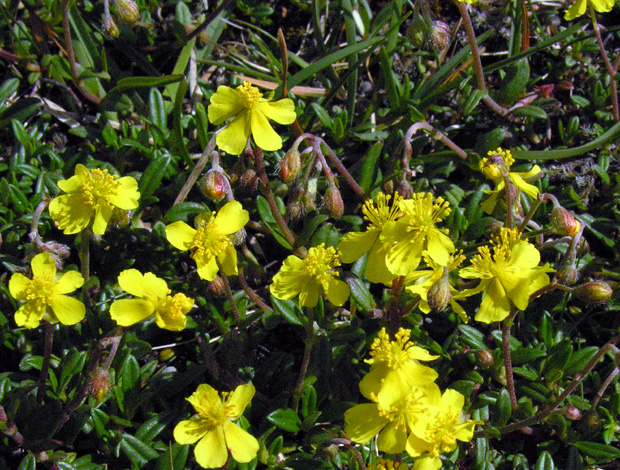Helianthemum oelandicum ssp levigatum Hoary Rockrose RR DDD N English Endemic

I don't normally put the exact location of rarities on the site but the position of this English endemic sub species is made obvious by the huge enclosures on the top of Cronkley Fell. There is no stile so you have to clamber over the galvanised rabbit proof fences. The change in habitat is quite astounding as you climb to the top of this 1,700 foot hill. First you start off in limestone country around the River Tees and then you ascend into a habitat where Heathers, Nardus stricta (Mat Grass) and Galium saxatile (Heath Bedstraw) all indicate an acid soil. Then right at the top the hill there is a cap of the special Sugar limestone which is the preferred substrate for some of the Teesdale specialties. Sugar limestone is limestone which has been partially baked by igneous intrusions of Whin Sill dolerite (a coarse grained basalt) which have changed it into a crystalline type of marble. This metamorphic rock is hard and slow weathering produces coarse crystals.
All round the many plants of this sub species there were grains of what could be mistaken for white sand but which are the "sugar" of the sugar limestone. This sub species is at first glance similar to the Irish one (ssp piloselloides) in that there is little hoariness to be seen and the leaves look almost glossy green. They are hoary underneath but the hoariness of ssp incanum is apparent immediately you see it. The leaves are said to be stubbier than the other sub species and there are supposed fewer flowers per pedicel but you would be hard pushed to know the difference between these plants if they grew together. Quite frankly, as the man said, I don't believe it.
Top of Cronkley Fell, Teesdale 22nd June 2005
Added on June 25th 2005, updated 5th February 2009, updated 6th April 2010



